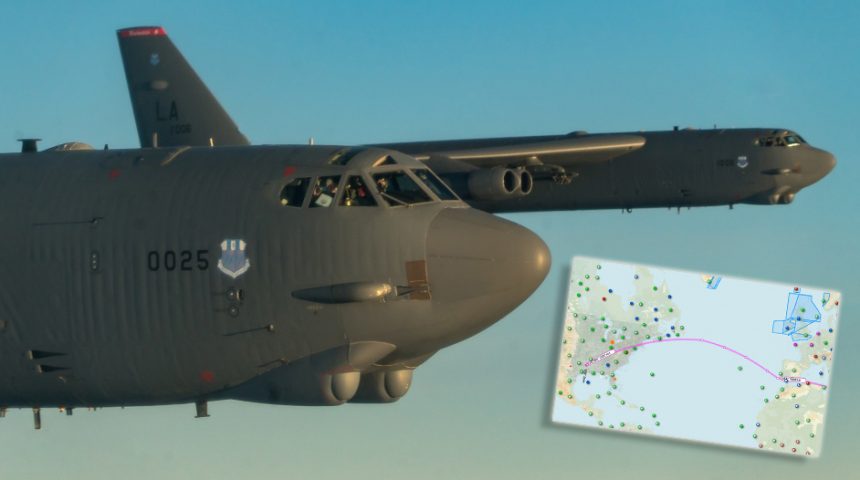The strategic bombers and their support tankers could be tracked online as they moved from Barksdale Air Force Base to the American outpost in the Indian Ocean as part of the U.S. build up in the region.
On Jan. 6, 2020, the first two of six U.S. Air Force B-52 bombers have departed their homebase, Barksdale AFB, Louisiana, to deploy to Diego Garcia.
Once again, some interesting details about their deployment (i.e. the time of departure, route, callsigns, support tankers etc.) could be gathered by OSINT (Open Sources Intelligence), exploiting ADS-B, Mode-S, MLAT and radio comms analysis: in fact, as already happened earlier this year, when two “BUFFs” deployed to Al Udeid, Qatar, the first pair of B-52s deploying to Diego Garcia could be tracked online via information in the public domain.
Three B-52s launched from Barksdale AFB under callsign MYTEE 51-52-53 at around 18.00Z.
6 JAN: USAF B52s MYTEE51 MYTEE52 & MYTEE53(airspare) departed Barksdale at approx 1800z – to Diego Garcia pic.twitter.com/1P8sKnIVKI
— Mil Radar (@MIL_Radar) January 7, 2020
However, just two aircraft (51 and 52) eventually crossed the Atlantic Ocean and through the Med towards their destination, with the third (MYTEE 53), most probably (since some says there was also a MYTEE 54 that possibly went tech) acting as an air-spare, returned to Barksdale AFB.
MYTEE53 is air-spare returning to Barksdale pic.twitter.com/10mQH7b3Rb
— Aircraft Spots (@AircraftSpots) January 6, 2020
#MYTEE53 returning to #KBAD (#Barksdale) via BOS KRAZE LUNDY TRENT BEVEE SQS. #MYTEE51-52 will cross the pond. pic.twitter.com/bwyHYsLXz9
— Rick Olthuizen (@ADSB_not_ACDC) January 6, 2020
The two remaining B-52s continued to corss the Pond, at block level FL270-280, M 0.75,
#MYTEE51-52 received oceanic clearance to FJDG (#DiegoGarcia): 4600N04500W 4445N03500W 4230N02500W GUNTI LATRU at FL270-FL280, Mach .75 pic.twitter.com/a0fvcIoozw
— Rick Olthuizen (@ADSB_not_ACDC) January 6, 2020
Along the route the aircraft provided constant position reports on HF frequencies:
#MYTEE51-52 position report 46N045W at 0005z, estimating 4445N03500W at 0100z, 4230N02500 next.
Frequency change at 45N (to #SantaMaria): 5598 kHz (secondary 3016)
— Rick Olthuizen (@ADSB_not_ACDC) January 7, 2020
Their radio comms can be heard online as well on LiveATC.net.
Listen to MYTEE51 and MYTEE (B-52’s to #DiegoGarcia):
Gander 5616 LiveATC: https://t.co/IgWXAptrRV
Next 5598 LiveATC: https://t.co/MXqoZjSiXe @inteldoge @intelcrab @Breaking911
— Arturas Kerelis (@arturasjk) January 7, 2020
The mission was supported by multiple tankers: at least 4x KC-10A Extenders (using radio callsign “SPUR51-52” on the East Coast and “RCH021-022” in Europe around the southern tip of the Iberian Peninsula) were identified:
Here’s a quick overview of how 4 KC-10A Extender aircraft may have refueled twice two B-52H Stratofortess bombers #MYTEE51 and #MYTEE52 currently still en route to Diego Garcia around tensions with #Iraq/#Iran.#SPUR51 87-0124#SPUR52 79-1712#RCH021 86-0035#RCH022 84-0188 pic.twitter.com/17e2Vn2fat
— Gerjon | חריון (@Gerjon_) January 7, 2020
It’s not clear the route the aircraft flew after crossing the Mediterranean Sea. Actually, it’s not even sure they continued together since they sometimes split and follow different routes to their final destination. For instance, in May 2019, while deploying to Al Udeid, MYTEE 51 and 52 flew different routes after reaching the eastern Med: one crossed the Israeli airspace, went into Jordan, then Saudi Arabia to land in Qatar; the other one took a southeasterly route, via the Egyptian airspace, over the Red Sea south of Sinai, then into Saudi Arabia.
Anyway, four more B-52s (most probably following the same route) are expected to deploy in the next hours. Expect to be able to track these online as well (as done with the cargo planes involved in the military build-up in the region following the attack on US Embassy in Baghdad).
And before some of our readers start complaining about OPSEC, I’d suggest them to read all the articles we have published on this subject since 2011 (some are linked above) and the following excerpt, from a story published in 2018:
However, based on our experience, proper procedures should be adopted (provided they are not there yet) in order to prevent big OPSEC failures. Indeed, whilst securing ADS-B is a must, it’s probably more important to turn off the Mode-S and ADS-B transponders when conducting missions that need to remain invisible (at least to public flight tracking websites and commercial off the shelf receivers). Unless the transponder is turned on for a specific purpose: to let the world know they are there. In fact, as reported several times here, it’s difficult to say whether some aircraft that can be tracked online broadcast their position for everyone to see by accident or on purpose: increasingly, RC-135s and other strategic ISR platforms, including the Global Hawks, operate over highly sensitive regions, such as Ukraine or the Korean Peninsula, with the ADS-B and Mode-S turned on, so that even commercial off the shelf receivers (or public tracking websites) can monitor them. Is it a way to show the flag? Maybe.









